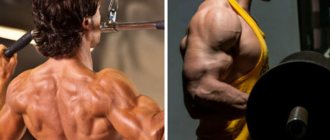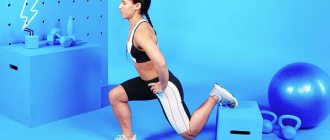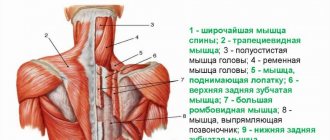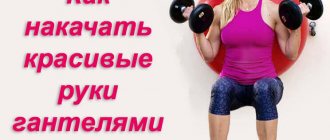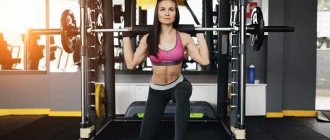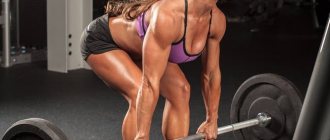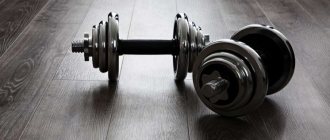Safety rules for performing back exercises
- Perform back exercises in the gym only if there are no contraindications from a doctor (serious illnesses, injuries).
- Back training in the gym must begin with a warm-up.
- Follow the technique (it is better if an experienced trainer shows you all the exercises).
- Increase the load gradually.
- Avoid sudden movements.
- At the first sign of discomfort or pain, stop performing back exercises in the gym and consult a doctor.
Back training plan
Before back training, be sure to warm up and cool down after training. To do this, we recommend looking at our selection of exercises: Warm-up and cool-down for back training. A good warm-up and cool-down will help you train more effectively and protect yourself from injury.
Lesson plan:
- Perform each exercise for 3-5 sets of 10-12 repetitions.
- Rest 30-60 seconds between sets.
- Rest 3-5 minutes between exercises.
- Do a back workout no more than once a week.
Back training plan No. 1 (barbell only)
1. Barbell deadlift
2. Bent-over barbell row with an overhand grip
3. Bent-over barbell row with reverse grip
4. “Good morning” with a barbell
5. Standing barbell shrugs (for trapezius)
Back training plan No. 2 (barbell + dumbbells)
1. Barbell deadlift
2. Bent-over barbell row with an overhand grip
3. One-arm dumbbell row
4. Romanian deadlift + straight-grip dumbbell row
5. Dumbbell plank row
Back training plan No. 3 (dumbbells only)
1. Deadlift with dumbbells
2. One-arm dumbbell row
3. Bent-over dumbbell rows with an overhand grip
4. Romanian deadlift
5. Simplified boat
Hyperextension for the back
To perform this exercise, you need a special back exercise machine. Well strengthens the muscles of the lumbar region. You need to take a position in the machine so that your ankles are under the lower rollers, and the upper roller is at hip level. So, you need to ensure that both your legs and your back are on the same straight line. Your hands can be held in front or behind your head. Slowly bend forward and return to the starting position. Hyperextension for the back is a very popular exercise for working the gluteal muscles.
Barbell row to the waist
The purpose of the exercise is to work out the central part of the back and thicken the muscle fibers.
The technique is as follows:
♦ take the barbell with a grip width at shoulder level, move your hips back, bend your legs slightly at the knees, bend almost parallel to the floor;
♦ while exhaling, pull the barbell almost touching the hips to the waist; at the top point, it is advisable to wait a pause and lower the barbell, allowing it to fall low until you feel a stretch in the back muscles, but without rounding it;
♦ when pulling the barbell to the belt, do not allow the body to rise, otherwise part of the load will move to the upper trapezius;
♦ the abdominal muscles should always be tense, this will keep the lower back muscles in constant tension;
♦ watch your elbows, they move along the body and do not spread to the sides.
Pull-ups and rows of the upper block to the chest
To perform this you need a special exercise machine for the back (spine). Direct grip pull-ups are performed as follows:
- you need to grab the bar slightly wider than your shoulders;
- shoulders down, shoulder blades retracted;
- then pull your arms up so that your chin is higher than the bar;
- movements should be smooth, without rocking.
The pull-down of the upper block to the chest is performed according to the principle of pull-ups, but on a machine. You need to sit on the machine, take its handles and, with a wide grip, pull the handle towards you to chest level, bringing your shoulder blades together. Then smoothly return the handle back. The lower back must be arched during the exercise.
Back exercises with dumbbells
DUMBBELL ROW TO THE BELT IN AN INCLINED
Impact: The exercise works each half of the back , while the strong half does not help the weak, unlike performing this exercise with a barbell.
Description: starting position - legs slightly bent at the knees, back parallel to the floor, dumbbells in lowered hands, palms facing each other, head raised up. We pull the dumbbells to the belt as high as possible. Lower the dumbbells to the starting position. Repeat the movement.
ONE DUMBBELL ROW TO THE BELT IN AN INCLINED
Impact: the exercise is isolating for each half of the back. The main effect is on the latissimus muscles , secondary on the biceps, posterior heads of the deltoid muscles and forearm muscles. Unlike performing this exercise with a barbell, with dumbbells the range of motion is greater.
Description: starting position - standing, back parallel to the floor, one hand holding a support, with the other hand take a dumbbell, palm facing you. Keeping your core still, pull the dumbbell as high as possible toward your chest. Lower the dumbbell to the starting position.
Option: to achieve greater core stability, you can rest your knees on the bench.
SHRUGS WITH DUMBBELLS
Impact: the exercise affects the trapezius muscles . Performed with heavy weight.
Description: starting position standing, feet shoulder-width apart, dumbbells in arms down, palms facing each other. From this position, raise your shoulders as high as possible and pause at the top point. Return to the starting position.
Low bar pull-ups
Somewhat easier to perform than regular pull-ups. Fix your hands on the bar with a “lock” grip. Head, legs and back in one straight line, heels to the floor. The arms need to be pulled to the bar so that the shoulders drop down and back, and the elbows are pressed to the sides and form a right angle. Then slowly return to the starting position.
In addition to all the listed exercises in the gym, you can do back strengthening at home, for this there are:
- exercise machines for spinal rehabilitation at home;
- spinal stretching machines;
- a device for stretching the spine on a horizontal bar.
Before using them, it is better to consult with an orthopedic doctor.
Features and rules of effective training
Exercises with a barbell can be performed by people for whom compression load on the spine is not recommended. However, to avoid injury, several rules must be followed. How to pump your back and stay healthy:
- monitor the work of the muscles, since traction should be carried out with the back and rear deltas;
- adhere to a moderate pace without sudden or, conversely, too slow movements;
- control every action (from the moment of raising to lowering the bar), you cannot suddenly drop the projectile;
- Before starting the workout, warm up each ligament, and only then do working approaches.
Some beginners pay attention only to the latissimus muscles. In this case, the back will be pumped unevenly or pain will appear from overexertion. In fact, a man needs to work 3 zones with a barbell: upper (trapezius, rear deltoids), middle (latissimus and extensor muscles) and lower (lower back). In addition, diseases of the musculoskeletal system may occur due to improperly distributed load during training.
There are a lot of advantages to doing back exercises with a barbell, and the main one is that you can do it at home; you don’t need anything other than equipment. It is possible to train many areas by choosing different deadlift styles. When performed correctly, there is no load on the spine, which means that even people with spinal diseases can pump up muscles. After just a few weeks of regular exercise, progress will be noticeable: an increase in strength, muscle volume, and physical endurance.
How to pump up your upper back in the gym
To effectively pump the upper back muscles and give them attractive definition, you should pay special attention to training in the gym. This complex consists of the best exercises for the upper back, by performing which you can not only build muscle mass, but also strengthen the spine and lower back
We recommend a set of exercises in the gym for beginners.
A set of exercises for the upper back in the gym
| Exercises | Sets | Repetitions/Time |
| Wide grip pull-ups | 3 | 8-12 |
| Vertical block row in front of you | 3 | 15 |
| Pullover dumbbell | 3 | 10-12 |
| Reverse fly with dumbbells | 3 | 15-20 |
| Shrugs with a barbell | 3 | 20 |
Wide grip pull-ups
Performance:
- Grab the horizontal bar with an overhand grip. The distance between the hands corresponds to the width of the shoulders. Relax your torso. Cross your legs together.
- Bend at the waist. Pull yourself up. Touch the bar with your chest. Try to bring your shoulder blades together. Do the exercise slowly. Don't swing.
Vertical block thrust
Read: A set of back exercises with dumbbells for men
Performance:
- Take a seat in the exercise machine. Grab the bar so that the distance between your hands is greater than shoulder width.
- Exhaling, lower the bar to your chest. Stay in position for 2 seconds.
- Take a breath. Smoothly return the block to its previous position. Your arms should be fully straightened.
Vertical block thrust
Pullover dumbbell
Performance:
- Lie across or along the bench. The upper back and neck will be on it. The side surface of the bench will become a support for the head.
- Raise your arms with a dumbbell above your head. Then lower it behind your head, maintaining the position at the lowest point. Return to the starting position.
Reverse fly with dumbbells
Read: Quadratus lumborum exercises
Performance:
- Sit on a bench. Press your chest towards your legs. Hold dumbbells in slightly bent arms.
- Raise your arms with dumbbells. Stay at the top. Repeat the movement you have already mastered.
Reverse fly with dumbbells
Performance:
- Grab a barbell and hold it while standing. Place your arms along your body.
- At the same time, raise your shoulders as high as possible. It is permissible to lower your chin: this will increase the load on the muscles.
- Drop your shoulders. The arms remain straight. Do not relax your shoulders at the lowest point, do not rotate them for the safety of your joints.
Shrugs with a barbell
How to pump up the upper back for men: training nuances
For men, it is enough to exercise twice a week to pump up the back muscles. Do the exercises as many times as your physical fitness allows. Use weights whenever possible. Try to progress the load. You should start your workout with basic back exercises and end with isolated exercises. After each strength exercise, stretch your muscles. Men who are aiming to work on muscle mass and back relief should perform the exercises 15 times in 3 approaches. If the goal is to develop strength, reduce the repetitions to 7. When working on endurance and strengthening the back, do 20-25 repetitions.
Read: Complex: healthy spine and lower back
Features of women's training
Start training by performing a small number of repetitions. Additional weight should not exceed 5 kg. Women should pay attention to basic exercises for the upper back. It is preferable to perform rows of blocks, dumbbells, and pull-ups in a gravitron. Don't get carried away with deadlifting. If you feel discomfort, take a break and stretch the muscles being trained. Women are recommended to perform exercises of 15 repetitions in 3 sets.
Lying bar row
This back exercise with a barbell for girls and men has many fans. It allows you to qualitatively work the upper back, trapezius, deltoids and latissimus muscles. To perform it, you will need not only a bar, but also a bench (you can use a chair or some other elevation at home).
The starting position should be taken like this:
- Set the bench incline to 45 degrees.
- Lie on your stomach and rest your feet on the floor.
- Take the projectile with an overhand grip, placing your hands shoulder-width apart.
- Direct your gaze forward.
- Hold the bar with your arms extended and tense.
Technique:
- Pull the projectile toward your waist, bending your arms and bringing your shoulder blades together.
- Hold for a couple of seconds, feeling the tension in your back.
- Smoothly straighten your arms and lower the bar down.
Recommendations:
- It is better not to tear your elbows away from your body so as not to transfer the load to your shoulders.
- For greater safety, you should use straps or special gym gloves that secure the hand.
- There is no need to lift your chest off the bench while lifting the bar, as this will put serious stress on your lower back.
- When performing, movements should be smooth.
Deadlift
Classics of the genre. It works almost all the muscles of the body at the same time, however, the back muscles in this exercise, with the correct technique (keep your back straight and do not hunch), work only statically and not dynamically (maintain tension, but do not move). However, given the relatively heavy weights used in this exercise, the deadlift has earned its honorable status among back exercises.
There are various deadlift techniques such as sumo deadlift, classic deadlift, and trap bar deadlift. Often, when working with large weights, a multi-grip or straps are used to prevent the bar from rolling out of the hands and from loosening the grip.
It is advisable, if possible, to use a classic grip without straps, as this will further develop grip strength, but the strength for this is not enough until the use of different grips and straps is permissible.
When using large weights, this exercise is considered quite dangerous for the back. Therefore, it is extremely important to follow the correct technique here, and you should not always chase record weights and single lifts to the maximum. On large scales you need to use a belt. Quite often there are and have been cases where people injured their backs with this exercise, so be extremely careful with it.
We also have an article about what exercises can replace deadlifts.
Clean up
The effect of such a back exercise with a barbell is expected to be simply incredible, which is quite possible. In this case, the thighs, lower legs, trapezius, buttocks, latissimus dorsi and extensor spinae are worked. When performed correctly, amateur athletes who already have a slightly toned figure will feel the rectus abdominis muscle. This exercise falls into the category of functional strength exercises, so it can be very difficult for beginners.
The initial position should be like this:
- Place the bar on the floor and get close to it, placing your shin a couple of centimeters away from it.
- Place your feet shoulder-width apart and turn your toes out.
- Lower yourself into a half-squat position and grab the bar with a medium grip.
- Bend at the lower back, squeeze your shoulder blades together as much as possible and straighten your arms.
Performing a chest raise:
- Tightening your core muscles, lift the projectile from the surface and smoothly pull it up to the level of your mid-thigh.
- Perform a sharp lift - simultaneously straighten your legs and back, set the barbell in an “upward” direction.
- Sit under the apparatus, bring your elbows forward and place the bar clearly on your chest.
- Straighten your legs.
- Return to starting position.
Important points:
- You cannot hunch over, move the bar away from your legs, connect your knees, move the weight only on your hands and withstand long pauses between movements in one repetition.
- While the barbell is in “free flight,” it is necessary to cushion it with your knees.
- When jerking, you just need to lean back a little, while simultaneously moving your pelvis forward to maintain balance.
- Straps should not be used as they increase the risk of injury.
What back muscles can be pumped up with a barbell?
A beautiful back is formed not only by the latissimus muscles, but also by the trapezius, rhomboid muscles, rear deltoids, and teres major muscle. They are involved in almost all basic back exercises, but by changing the grip or angle, you can put emphasis on different muscles.
Basic back exercises with dumbbells and a barbell train:
- trapezius muscles located in the upper back and neck;
- the latissimus dorsi muscles, which begin in the back of the armpits and go down to the waist;
- back straighteners (lumbar area), which do not affect the appearance, but stabilize the back in heavy basic exercises.

